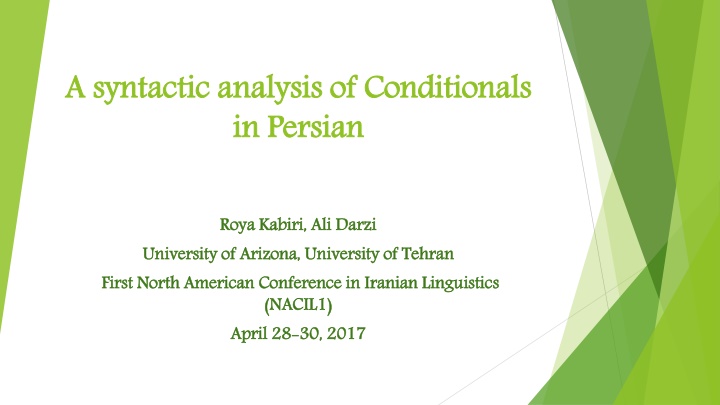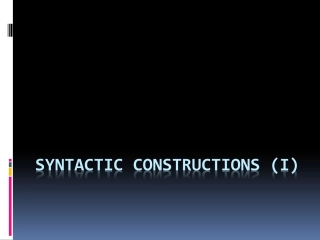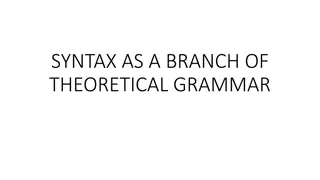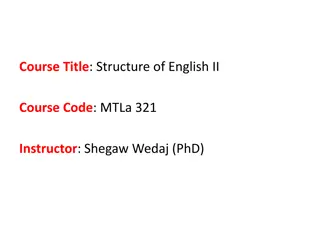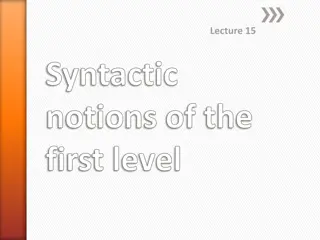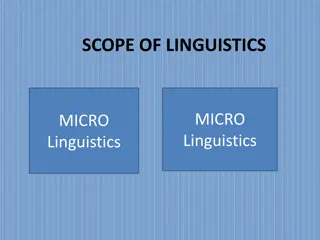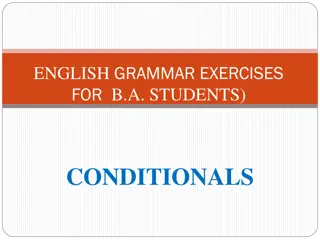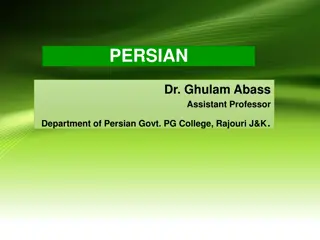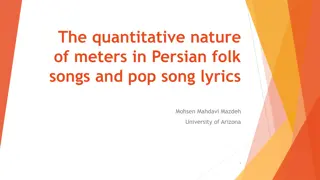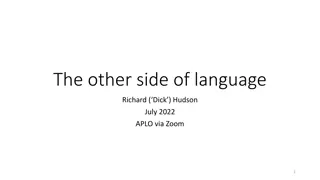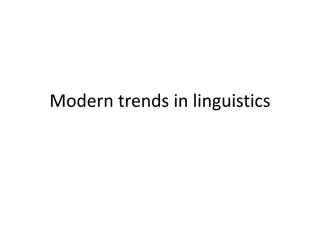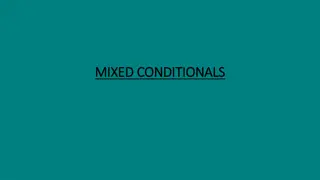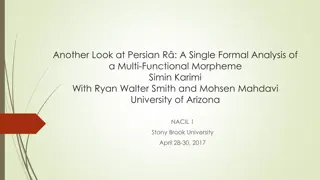Syntactic Analysis of Conditionals in Persian Linguistics
This study delves into the structural position of conditionals in Persian, examining sentence-initial, sentence-final, and seemingly sentence-medial clauses to assess existing theories' applicability.
Download Presentation

Please find below an Image/Link to download the presentation.
The content on the website is provided AS IS for your information and personal use only. It may not be sold, licensed, or shared on other websites without obtaining consent from the author.If you encounter any issues during the download, it is possible that the publisher has removed the file from their server.
You are allowed to download the files provided on this website for personal or commercial use, subject to the condition that they are used lawfully. All files are the property of their respective owners.
The content on the website is provided AS IS for your information and personal use only. It may not be sold, licensed, or shared on other websites without obtaining consent from the author.
E N D
Presentation Transcript
A syntactic analysis of Conditionals in Persian A syntactic analysis of Conditionals in Persian Roya Roya Kabiri Arizona, University of Tehran Kabiri, Ali , Ali Darzi Darzi University of First North American Conference in Iranian Linguistics (NACIL April University of Arizona, University of Tehran First North American Conference in Iranian Linguistics (NACIL1 1) ) April 28 28- -30 30, , 2017 2017
Outline Provide definition of conditional propositions. Introduce two distinct views on the structural position of the conditionals in the literature: Bhatt and Pancheva (2006) Valmala (2009) Introduce sentence-initial, sentence-final and seemingly sentence- medial conditional clauses in Persian. Examine Persian conditionals in order to understand how these constructions are structured, and whether or not the existing theories can account for them. Outline
Conditional Conditional s structures tructures Conditionals are linguistic expressions expressed by means of syntactically complex forms which consist of a conditional clause (protasis or antecedent) and a main clause (apodosis or consequent). Conditionals involve an adverbial clause which makes the occurrence of one event dependent on the occurrence of another (Inchaurralde 2005).
Conditionals have been one of the most significant topics in the areas of semantics, pragmatics and philosophy of language, and have been studied within different approaches (Kratzer 1986, Kaufmann 2001). They have not been analyzed syntactically in detail, specifically in Persian.
S Structural position tructural position of conditionals of conditionals Syntactically, there is a debate as to how these expressions are constructed: First It is an adjunction-based approach (proposed as equivalent to external merge). The sentence-initial conditional clause in English adjoins to TP and in some cases to CP (when preceding wh-arguments in questions). The sentence-final conditional clause involves VP-adjunction to the right. First approach approach due due to to Bhatt Bhatt and and Pancheva Pancheva ( (2006 2006) ): :
Second Spanish and English sentence-initial conditional clauses are in the Spec of TopP or FocP. The sentence-final conditional clauses are in the Spec of a functional projection, CondP. This analysis is based on movement (proposed as equivalent to internal merge) in some cases. The sentence-initial conditional clause has a topic or focus interpretation, and it is usually derived via movement from a post verbal position to the front of the sentence. Second approach approach due due to to Valmala Valmala ( (2009 2009) ): :
C Conditionals onditionals in in Persian Persian Conditional marker: g r if or more informally ge. Three different positions of the conditional clause: sentence-initial (1a), sentence-final (1b) and seemingly sentence-medial (1c): (1)
We show that the adjunction-based approach (proposed by Bhatt and Pancheva (2006)) rather than the other approach advocated by Valmala (2009) best accounts for the data in Persian. Independent syntactic properties such as the interaction of scrambling and principle C of Binding Theory, the structural position of focused wh-arguments, distribution of higher and lower adverbs and vP deletion provide evidence for our analysis.
The sentence The movement-based analysis cannot account for a sentence-initial conditional clause containing a referential expression a pronominal Taking into account the interaction of scrambling and principle C of Binding Theory, the sentence in (2) would be predicted to be ill- formed under the movement-based analysis due to the principle C violation, contrary to facts. (2) The sentence- -initial conditional clause initial conditional clause referential expression, coindexed with pronominal in the matrix clause.
If the conditional clause is generated in a position following the main clause and then moved to its surface position, it should be ungrammatical since: Reconstruction is well-known to be obligatory for principle C at LF (See Iatridou 1991, Sportiche 2005, Valmala 2009) Scrambling does not bleed principle C in Persian (Karimi, 2005: 179). Thus, the sentence-initial conditional clause is externally merged as an adjunct to TP which is not c-commanded by the subject in the main clause.
Taking into account principle C and the distribution of lower adverbs in Persian (lower adverbs are adjoined to the vP (Karimi, 2005: 125)): The sentence-initial conditional clause is adjoined to TP. (3)
If a matrix clause containing a focused wh-argument (occupying the Spec of FocP upon movement in Persian (Karimi 2005)), is preceded by a conditional clause, it can be argued: If the wh-argument ki who is in the Spec of FocP, it is not possible for the conditional clause to simultaneously occupy this position. Persian allows two elements bearing contrastive focus in the same sentence only if at least one of them bears an inherent focus. Focus position is argued to be unique in Karimi (2005). Following what Bhatt and Pancheva (2006) proposed for English, the conditional clause may adjoin to FocP as well. (4)
It may be argued that they are in the multiple specifiers of FocP: Karimi (2005): two focused elements moved to Specs of FocP may not be separated by other syntactic objects. F rda tomorrow may be construed as a temporal adverb for both the conditional clause and the matrix clause, indicating that there is no adjacency requirement between the wh-argument and the conditional clause. (5)
Syntactic Syntactic position position of of the the sentence sentence- -initial initial conditional conditional clause clause: : It involves TP-adjunction and FocP-adjunction (when preceding the focused wh-arguments which have moved to Spec of FocP). This analysis offers support for the Bhatt and Pancheva s (2006) analysis. It is also consistent with some other studies (Haegeman 2004, Iatridoue 1991) which consider conditional clauses as adverbial clauses in adjunct positions as they are not triggered by the need to check features (Chomsky 1995).
The sentence Sentence-final conditional clauses involve vP-adjunction: Principle C of the Binding Theory vP deletion The sentence- -final conditional clause final conditional clause Since sentence-initial conditionals, to maintain consistency I extend the adjunction-based approach to sentence-final conditionals as well. the adjunction-based approach accounted for the
Ill-formedness of sentence (6) is due to a principle C violation because the pronominal subject of the main clause binds the subject of the embedded clause adjoined to vP. The sentence-final conditional clause is adjoined to a position lower than TP (the most likely candidate being the vP) inducing principle C violation. (6)
The asymmetry observed in the behavior of sentence-initial and sentence-final conditional clauses: It is possible to have a referential expression in the sentence- initial conditional clause coreferent with a pronominal subject in the main clause. It is impossible to have a referential expression in the sentence- final conditional clause coreferent with a pronominal subject in the main clause. Sentence-initial and sentence-final conditional clauses are merged in different positions in the derivation.
vP deletion shows the sentence-final conditional clause is in a position lower than NegP, the most likely candidate being the vP. In (7), all constituents below the NegP, including the conditional clause are elided, leaving the subject and the head Neg intact. (7)
Syntactic Syntactic position position of of the the sentence sentence- -final final conditional conditional clause clause: : It is adjoined to the right of the vP. It is compatible with Bhatt and Pancheva s (2006) analysis.
Our proposal for the TP and FocP adjunction of sentence-initial conditional clauses can also account for: The grammaticality and ungrammaticality of all the sentences in which the conditional clause appears in the medial position. (8)
The sentence in (9) with two topicalized DPs preceding the conditional clause is also explained under our proposal. More than one syntactic object may be topicalized in Persian (Karimi 2005). (9)
The ungrammaticality of (10) is due to: Topicalization of the pronominal un to the front of the sentence, places it in a structural position from which it binds the referential expression in the conditional clause, inducing principle C violation. Scrambling feeds principle C in Persian (Karimi 2005: 180). (10) un he from the main clause subject
Syntactic position of conditional clause: Syntactic position of the seemingly sentence conditional clause: the seemingly sentence- -medial medial The merge position of the seemingly sentence-medial conditional clause is in no way different from the sentence-initial position. The relative ordering between the conditional clause and the constituents preceding it, is due to scrambling of syntactic constituents to the sentence-initial position.
Conclusions Conclusions The adjunction-based approach of conditionals proposed by Bhatt and Pancheva (2006) best accounted for the data in Persian over the other approach advocated by Valmala (2009). The conditional clause was argued to be an adverbial clause in Persian adjoined to the TP or FocP in sentence-initial position, and to the right of the vP in sentence-final position.
Future Research Future Research Why left-adjunction is restricted to TP or higher projections such as FocP whereas right-adjunction is restricted to vP? Is there syntactic differences among various kinds of conditional clauses classified in terms of syntax/semantic grounds? Is there any connectivity effects that hold relative to tense/aspect, especially with counterfactuals that may have implications for the syntactic analysis? How does conditional clause interact with negation? How phase theory can account for the syntactic position of the conditionals?
Thanks for your attention! Thanks for your attention!
Conditional clauses may be focused. Under my analysis nothing prevents a conditional clause to be modified by f f q q t t as in (6). It doesn t mean that it is base-generated in that position. Actually, it is base-generated in the adjunct position of the TP and then may optionally move to Spec of FocP. (6)
